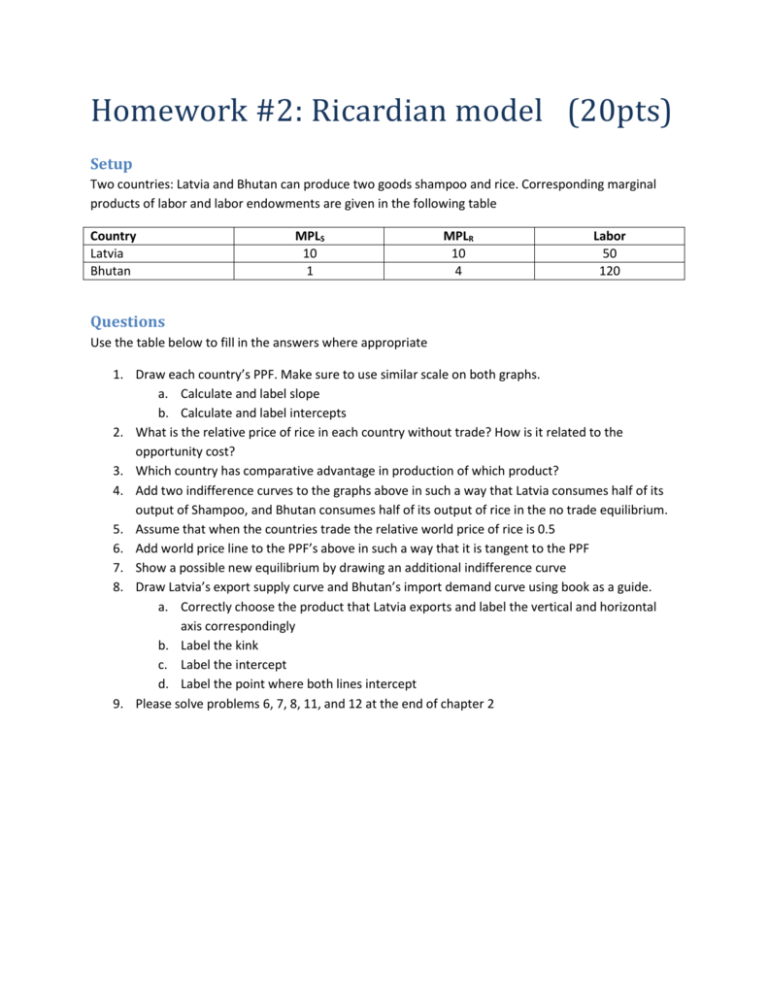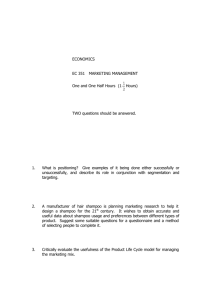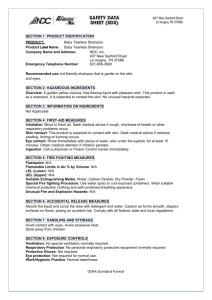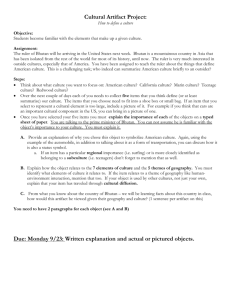The export supply curve
advertisement

Homework #2: Ricardian model (20pts) Setup Two countries: Latvia and Bhutan can produce two goods shampoo and rice. Corresponding marginal products of labor and labor endowments are given in the following table Country Latvia Bhutan MPLS 10 1 MPLR 10 4 Labor 50 120 Questions Use the table below to fill in the answers where appropriate 1. Draw each country’s PPF. Make sure to use similar scale on both graphs. a. Calculate and label slope b. Calculate and label intercepts 2. What is the relative price of rice in each country without trade? How is it related to the opportunity cost? 3. Which country has comparative advantage in production of which product? 4. Add two indifference curves to the graphs above in such a way that Latvia consumes half of its output of Shampoo, and Bhutan consumes half of its output of rice in the no trade equilibrium. 5. Assume that when the countries trade the relative world price of rice is 0.5 6. Add world price line to the PPF’s above in such a way that it is tangent to the PPF 7. Show a possible new equilibrium by drawing an additional indifference curve 8. Draw Latvia’s export supply curve and Bhutan’s import demand curve using book as a guide. a. Correctly choose the product that Latvia exports and label the vertical and horizontal axis correspondingly b. Label the kink c. Label the intercept d. Label the point where both lines intercept 9. Please solve problems 6, 7, 8, 11, and 12 at the end of chapter 2 Country Latvia PPF Bhutan QS QS 500 120 500 QR 480 Slope of the PPF -1 -1/4 Opportunity cost of rice Relative price of rice in no trade equilibrium Consumption of rice without trade Consumption of shampoo without trade Output in trade equilibrium 1 1/4 1 1/4 250 240 250 60 Output of rice = 0 Output of shampoo = 500 Output of rice =480 Output of shampoo =0 2 QR Export supply and import demand curves 4 2 1 60 250 QSH 3 QR In this section I graphically explain construction of the export supply curves and then below the graph I clarify the class discussion about the bounds on the export supply and import demand. Red arrows show the connections between parts of the graphs. Import demand crosses relative price 1 to the left of this line Export supply approaches but never crosses this line from the left 4 2 1 60 480 500 QSH 250 QS QS 500 480 Slope = -1 250 120 60 250 500 QR 240 4 480 QR The export supply curve: … is horizontal at 1 which is the opportunity cost of shampoo in Latvia. When the world price is exactly equal to the domestic opportunity cost the country is indifferent between producing any quantity of shampoo. Any number from 0 to 500 can be produced and then traded 1 to 1 (that’s the relative price) with the other country for the desired amount of rice. For example, Latvia can produce 400 units of shampoo and export 150. … the horizontal part ends at 250 which is the maximum that Latvia can export at the price of 1. The maximum they produce is 500, consumption at the price 1 is 250, so 500-250 are the exports. … approaches but never crosses 500, which is the maximum that Latvia (the country with the comparative advantage in production of shampoo) can produce. The import demand curve: … is horizontal at 4 which is the opportunity cost of the importer of shampoo … remains horizontal until 60 which is the maximum that Bhutan would import at the price of 4. Bhutan would import all 60 if it produced none. … starts sloping down from the kink and goes all the way to zero. This is the demand curve that shows how much Bhutan WOULD BUY at any given price. Whether it will actually buy that quantity is determined by the intersection with the supply. The import demand line is completely determined by the indifference curve after it starts sloping down. The equilibrium quantity will never exceed 500 because the supply does not go beyond 500. … crosses price 1 to the left of 480. To find out what is the maximum quantity of shampoo that Bhutan CAN (it might not want to) import at 1 we need calculate how much Bhutan can get if it produces rice and sells it all for shampoo. 480 units of rice traded for shampoo at 1 to 1 ratio gives us 480 units of shampoo. 5





